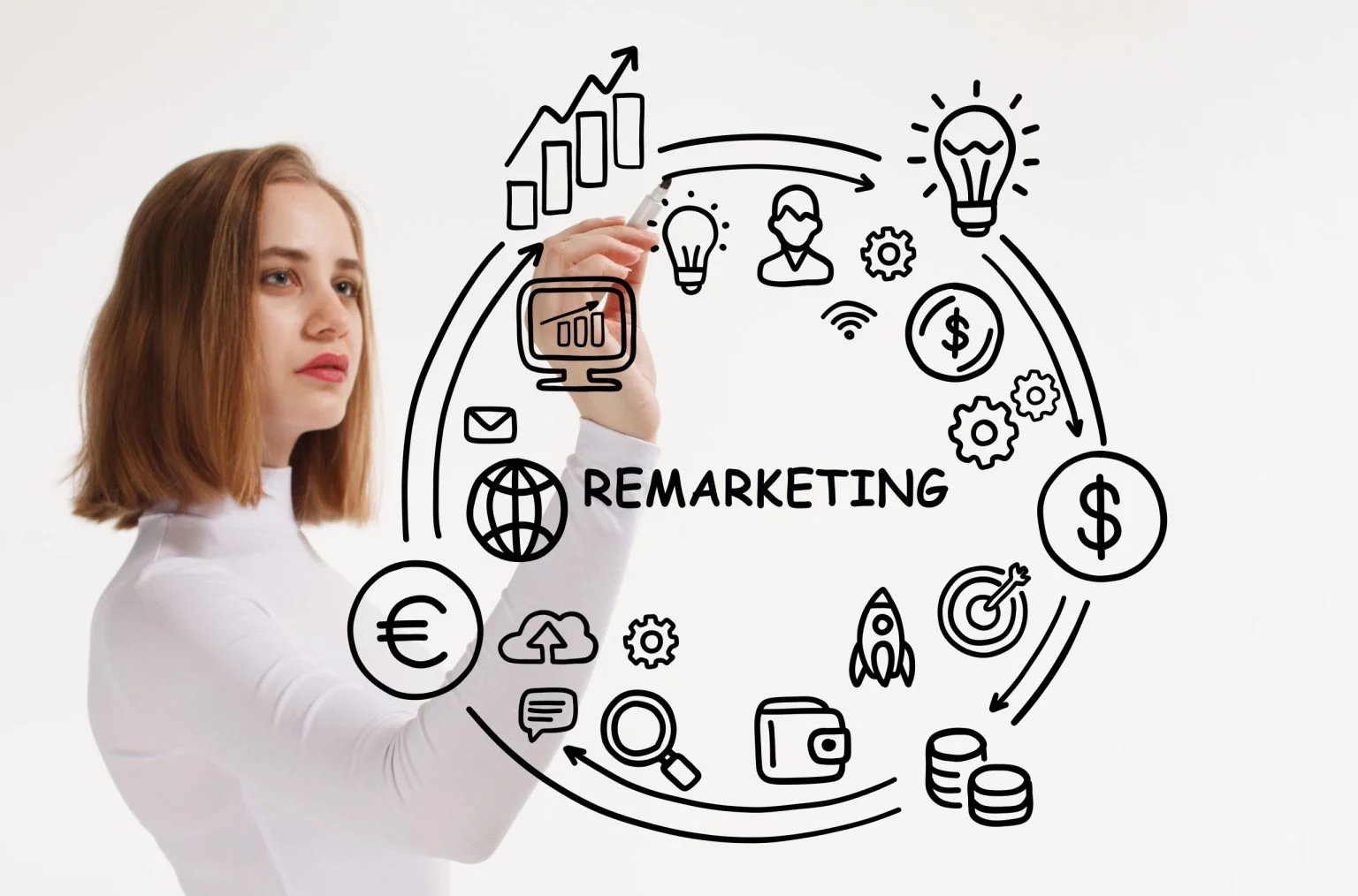A remarketing campaign is a powerful tool for businesses looking to boost their online presence with interested consumers near the bottom of the buying funnel. It is a highly effective way of reaching consumers who are close to taking action but haven't done so yet. We believe in it so much that we think remarketing ought to be a standard part of every digital campaign. Here's why.
What is Remarketing?
Businesses use remarketing to reach people who have already interacted with their website or mobile app. It involves bringing back previous website visitors who didn’t complete a desired action, such as making a purchase or filling out a form and converting them into customers.
By targeting previous website visitors or app users, you can increase the likelihood that these individuals will become paying customers. This post explores why remarketing is so effective, how it can be used to grow your business, and how you can launch and utilize your own remarketing campaign.
How Does Remarketing Work?
Through cookies or tracking pixels, remarketing collects information about visitors’ actions on a website or app, which is then used to display targeted ads as the visitors browse the web or use other apps.
Your chances of converting people into customers can be increased by then showing them ads that are personalized and/or relevant to them specifically.
There are several types of remarketing, including search remarketing, display remarketing, email remarketing, and social media remarketing.
Steps to Launching a Remarketing Campaign
1. Define Your Audience
A remarketing campaign starts with identifying your target audience. This could be people who have visited your site, added items to their shopping cart (but didn’t check out), or executed another action.
The better you define your audience, the more specifically you’ll be able to target them (see Step 5, below) and tweak your creative approach when making your ads (see Step 4, below).
2. Choose Your Platform
Your audience and goals (see Step 3, below) should determine which platform is best suited for your remarketing, including Google Ads, Facebook, and Twitter.
In fact, when it comes to remarketing, all three platforms can be effective in their own way. However, the platform that’s best suited for remarketing will depend on the specific needs and goals of your business. Here are some factors to consider:
- Audience: Each platform has a different user base, so it’s important to consider which platform your target audience is most active on.
- Ad Format: Different ad formats work better on different platforms. For example, Facebook and Twitter both have strong visual components, while Google Ads focuses on text ads and search ads.
- Ad Targeting Options: All three platforms have robust targeting options, but they differ in the types of data they use to target ads. Facebook, for example, has access to a lot of demographic and interest data, while Google Ads has access to search data.
- Cost: The cost-per-click (CPC) or cost-per-impression (CPM) can vary between platforms, so it’s important to consider which platform will give you the best return on investment (ROI).
If you want to target people who have already visited your website, Google Ads can be a great choice. If you want to target people based on their interests and behaviors, Facebook can be a good choice. If you want to target people based on their engagement with your tweets or Twitter profile, Twitter can be a good choice.
Ultimately, the best platform for remarketing will depend on your specific goals and target audience. It’s important to test different platforms and ad formats to see what works best for your business.
3. Set Your Campaign Goals
Remarketing campaigns can be used to boost website traffic, increase conversions, or boost brand awareness. As stated above, your goals can be a deciding factor in choosing your platform for remarketing. All three of these goals are important components of a successful digital marketing strategy, but the best approach will depend on what you’re trying to achieve.
Boosting website traffic can help drive traffic to your company’s online properties and increase visibility, which can lead to more leads and sales. Increasing conversions can help increase the likelihood that visitors to your sites will take a desired action, such as making a purchase, filling out a lead form, or signing up for a newsletter. Increasing brand awareness can be especially important for businesses that are new to the market or trying to establish themselves as thought leaders in their industry.
Of course, in practice, you’ll likely have a combination of these goals. It’s important to prioritize your goals and allocate your resources accordingly. It’s also important to measure your results (see Step 7, below) and adjust your strategy as needed to ensure that you’re making progress toward your goals.
4. Create Your Ads
Create eye-catching ads that will appeal to your target audience. Include a clear call-to-action (CTA) in each.
If you’ve never created an ad before, you might want to do some reading and/or watch some tutorials about copywriting and/or marketing. Another option is to hire an experienced ad professional who’s already versed in the creative tools that are needed to produce alluring ads.
Here are some brief guidelines for creating good CTAs:
- Be Clear and Concise: Your CTA should clearly state what you want the user to do and use simple, straightforward language.
- Use Action-Oriented Language: Use action verbs, such as “Buy,” “Download,” or “Sign Up,” to encourage users to take action. This will help create a sense of urgency and encourage users to act quickly.
- Make the CTA Visually Prominent: Your CTA should stand out and be visually distinct from other elements in an ad. Use contrasting colors, whitespace, and other design elements to draw attention to your CTA.
- Test and Optimize: You can test different variations of your CTA to see which one performs the best. Try different colors, language, placement, and design to see what works best for your audience.

5. Target Your Audience
Reach your target audience by targeting people based on their behavior on your website, their demographics, or their interests. Here’s a brief overview of the differences between these approaches:
- Behavioral Targeting: This approach involves targeting people based on their behavior on your website or app. This can include things like pages they’ve visited, products they’ve looked at, or actions they’ve taken (such as adding items to a cart). Behavioral targeting is a powerful way to reach people who have already shown an interest in your brand, making them more likely to convert.
- Demographic Targeting: This approach involves targeting people based on their demographic characteristics, such as age, gender, income, and education level. This can be a good way to reach a specific audience that may be more likely to be interested in your products or services.
- Interest Targeting: This approach involves targeting people based on their interests, hobbies, and activities. This can be a good way to reach people who may not have interacted with your brand much before but have shown an interest in related topics or products.
In practice, you can use a combination of these approaches to create a more targeted and effective remarketing campaign. For example, you might use behavioral targeting to reach people who have visited your website in the past, demographic targeting to reach a specific age or income group, and interest targeting to reach people who have shown an interest in related products or topics.
Overall, the key to effective ad targeting is to understand your audience and create ads that are relevant and compelling to them. By taking a data-driven approach and testing different targeting strategies, you can optimize your campaigns and achieve better results.
6. Launch and Monitor Your Campaign
Your campaign is ready to launch once your ads are created and your target audience is determined. After you launch your campaign, you should continuously monitor its performance and make adjustments as necessary. Monitoring a remarketing campaign is crucial to ensure that you’re achieving your desired results and making the most of your ad spend.
Here are some steps you can take to monitor your campaign effectively:
- Set Up Tracking: To monitor your campaign, you’ll need to set up tracking to measure the performance of your ads (see Step 7, below). This can include things like setting up conversion tracking to measure the number of people who complete a desired action (such as making a purchase or filling out a form) after clicking on an ad.
- Use Analytics Tools: Analytics tools like Google Analytics can help you monitor the performance of your campaign. This can include tracking metrics like click-through rates (CTRs), conversion rates, and cost per conversion. You can also use these tools to create custom reports and dashboards to track your performance over time.
- Monitor ad Spend: Keep a close eye on your ad spend to make sure that you’re not overspending or running out of budget before the end of your campaign. Use budget tracking tools or spreadsheets to monitor your spending and adjust your budget as needed.
- A/B Test Your Ads: Testing different variations of your ads can help you identify what works best and improve your performance over time. Test different ad copy, images, and targeting to see what drives the best results.
7. Measure and Refine
By tracking key metrics, such as click-through rates, conversion rates, and ROI, you can improve the performance of your remarketing campaign.
- CTRs: Click-Through Rates (CTRs) measure the percentage of people who click on your ad after seeing it. By tracking CTRs, you can identify which ads are resonating with your audience and which ones are not. You can use this information to adjust your ad copy, images, and targeting to improve your CTRs and drive more traffic to your sites.
- Conversion Rates: Conversion rates measure the percentage of people who take a desired action on your site after clicking on your ad, such as making a purchase or filling out a form. By tracking conversion rates, you can identify which ads are driving the most conversions and which ones are not. You can use this information to adjust your ad messaging, landing pages, and other elements of your campaign to improve your conversion rates and drive more revenue.
- ROI: ROI measures the revenue you generate from your ad campaign compared to the cost of running the campaign. By tracking ROI, you can determine whether your campaign is profitable and identify areas where you can cut costs or improve revenue. You can use this information to adjust your ad spend and other elements of your campaign to maximize your ROI and drive the best possible results.
By tracking these key metrics and using the insights you gain to adjust your campaign, you can optimize your remarketing campaign to achieve your goals and get better results over time.
Conclusion
In conclusion, remarketing is a valuable marketing strategy that can help businesses reach potential customers and increase conversions. The process of creating remarketing campaigns may sound involved, but once you run through it a few times, everything should make sense, and you’ll see how all the pieces fit together.Over time, remarketing can become such a natural approach, you’ll wonder why you didn’t use it before! Get in touch with us at fuze32 to learn more about our remarketing services. 



.webp)
























































